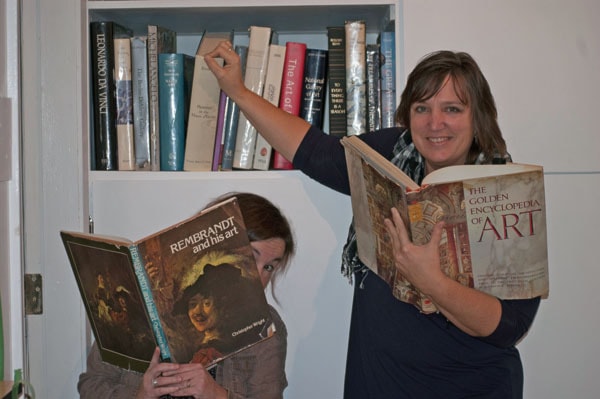A $3,000 grant from the Community Foundation is firing imagination and brewing surprises at the Salmon Arm Arts Centre.
Based on the premise that art is for everyone and is found in unexpected places, director/curator Tracey Kutschker and Shuswap District Arts Council Board member Louise Wallace are working together to bring the community into an exhibition that will run for two months next spring.
“Louise’s brilliant brainchild took on epic proportions,” says Kutschker of 2012’s well-received bike exhibition that attracted many people who had never been to the art gallery. “It took off, and then we thought, we need to do to another show about an object and how it affects our lives. It’s all about our relationship to these objects.”
With the belief that art is everywhere, including in the objects we use every day – like bicycles, books, movies, greeting cards and more, Wallace and Kutschker committed to having a least one show every couple of years that focuses on an everyday object.
Another goal is to demystify the art gallery, to make people of all ages, walks of life and interests to feel a sense of belonging and acceptance at their art gallery.
“The show was originally about books, then we decided that wasn’t enough, so it’s about storytelling,” laughs Wallace, a local publisher. “And now, like the bike show it’s taking off.”
What the women also realized was that the project goes beyond the art gallery, including more individuals, more organizations and more opportunities to reach out through art and deepen the connection to others.
“And it’s also about building new relationships with storytelling, because we’re in a rapidly changing world, so the role of technology and how it plays into storytelling can also be part of this project,” says Wallace. “Storytelling is in a very experimental phase right now – do we talk, text, Facebook? Do we blog? And how does that compare to how we told our stories in the past? And how will we tell our story in the future?”
Everyone has a story and all art is storytelling, says Kutschker, noting the exhibition will be one of many parts and many surprises.
“It will have a very collaborative feel and even the visitors will be asked to be part of the story,” she says. “One of the coolest ones is that we’ll have a live Twitter feed projected onto a wall of the gallery and anyone anywhere in the world can contribute.”
Also hanging in the gallery will be the work of 11 artists who will be commissioned to design a book cover for the as-of-yet unwritten story. And the theme is “The Best Story Not Yet Told.”
“The artists will only be told there will be an unfolding Twitter feed story, so they will imagine what will appear on the Twitter feed,” says Wallace. “It will show their take on storytelling in the 21st century.”
Another non-original, but new to Salmon Arm idea, is a living library where two strangers meet and one is the book and one is the reader.
The reader asks the book questions, and that could be asking questions of local scientists, artists, performers, First Nations and more. It might be a young person posing questions to a senior or, a senior rapping with a young boarder.
The project will be getting underway soon and will include sculptural seat installations – some inside and others outside – in customary and unexpected places.
“The outreach piece is important and will include the school district, Trail Alliance, Literacy Alliance, artists, authors, publishers, school kids, seniors and First Nations,” says Kutschker. “There might be a chair with books up at the rink; it’s about connecting with new people in new ways.”
“The only thing we can tell you for sure is, be prepared to be surprised,” adds Wallace. “It’s definitely experimental and unexpected.”
About eight large installations are under consideration now, but as the project is a collaborative one, the women are prepared to be open to change and adaptive. The project will culminate in an ebook and hard copy if there is demand.
Wallace and Kutschker are excited about the project and the $3,000 Shuswap Community Foundation grant that allows them to invest in an exhibition financially for the first time.
Kutschker and Wallace attended the Art Summit in Vancouver last June where several arts groups were invited to help create a framework for a provincial cultural policy.
“One of the things we took away from that was the need to experiment, to try new things, take small risks, adapt quickly, make mistakes and not get stuck,” says Kutschker. “Innovation is what we’re good at in the art sector, so if that’s our strength, let’s capitalize on it.”
“And don’t be afraid,” adds Wallace, pointing out non-profit organizations live in fear of losing their funding.
Kutschker says the summit was about community building too, and what is happening in the arts is often a precursor to what is happening in the community.
Describing cities as living things that die without change, Wallace says, adding the competition for residents’ interest and participation is even more challenging in small towns.
“The only way we’ll distinguish ourselves is by doing something different. We’re never going to be like Vancouver, so why try to be?” she asks. “We need to be authentic, which is then why we want to tell our story – a shared identity, a strong community built through storytelling…”
Kutschker and Wallace say the story of the bike exhibition went far and wide and is still the subject of enthusiastic conversation.
